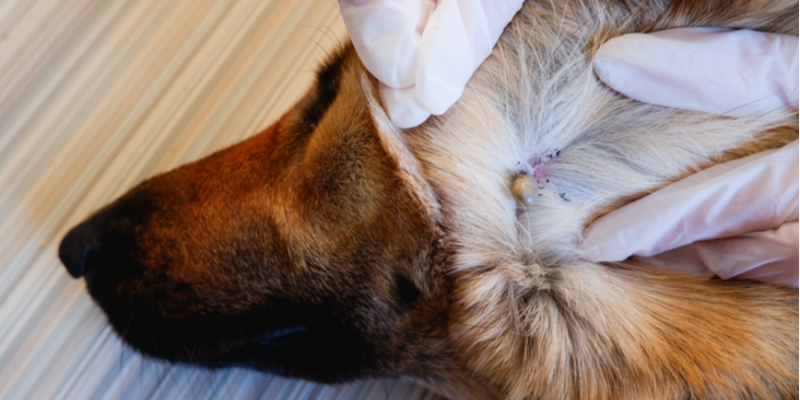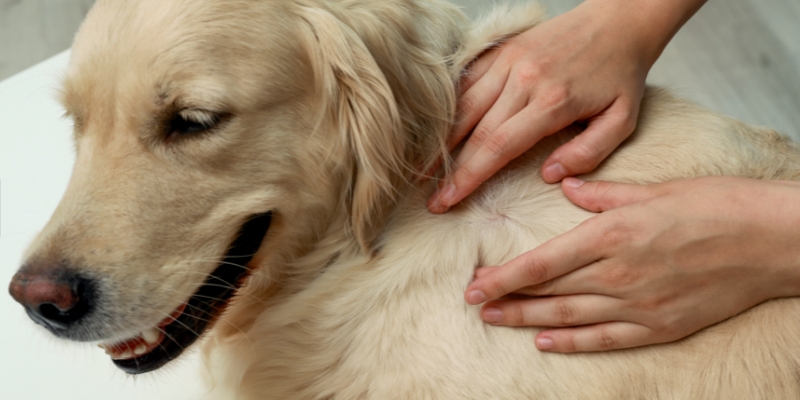Ticks are tiny, yet their impact on our pets’ health can be enormous, especially dogs. These small, blood-sucking parasites can carry a variety of diseases and illnesses including Lyme disease. As a responsible pet owner, it’s crucial to be informed about ticks, how to check for them, how to prevent tick bites, and how to treat them when they do occur. In this blog post, we’ll cover everything you need to know to keep your furry friends safe from these pesky parasites.
Checking Dogs
Checking your dog for ticks should be a regular part of your pet care routine, especially after they have been in areas where ticks are present. Ticks can be found anywhere on your dog’s body, but some common areas include the head, ears, neck, and feet. Ticks may also be found in the webbing between the toes, under the collar, or attached to the anus, so a thorough look everywhere on your dog is essential.
How to Check a Dog for Ticks:
- Run your hands over your dog’s skin, feeling for any small bumps that might be ticks. If you find a bump, part the fur in that area to inspect it more closely. Often, there is a small scab or small amount of dried blood around the bite.
- Alternatively, you can use a flea comb to inspect your pet’s skin and fur. If you feel something as you comb through your pet’s fur, part the fur to take a closer look.
Note: do not use a flea or other fine-toothed comb to remove a tick.
- Pay particular attention to the following areas during your inspection: in and around your dog’s ears, between the toes on each paw, under your dog’s tail, near your dog’s eyelids, under their collar, and in the armpits.

What Does a Tick Bite Look Like?
A tick bite appears as a circular area of inflamed skin, often red and slightly swollen after the tick is removed. Crusts or a scab may also form. The lesion can be itchy and irritating, prompting dogs or other pets to scratch or lick at it, which can lead to infection.
Identifying Ticks on Your Pets

Ticks come in various species, with the most common in North America being the American Dog Tick, Blacklegged (Deer) Tick, and the Lone Star Tick. These arachnids are not only nuisances but also potential carriers of deadly pathogens. Identifying them correctly is the first step in effective tick management.
- American Dog Tick: Recognizable by its dark brown body and off-white shield on females. It thrives in areas with little tree cover such as grassy fields and along trails.

- Blacklegged Tick: Known for transmitting Lyme disease, this tick has a reddish-orange body with a black shield. It’s commonly found in wooded areas across the eastern and northern U.S.

- Lone Star Tick: Easily identified by the white dot on the back of adult females, this tick’s bite can transmit multiple diseases and is prevalent throughout the Eastern U.S.

How to Remove Ticks from Your Dog
If you do find a tick on your dog or other pet, it is crucial to remove it completely. If a tick is not removed properly, the head of the tick can remain attached to your dog, causing irritation and potentially transmitting diseases.

Follow these steps to properly remove a tick:

- Choose the Right Tool: Utilize a tick removal tool rather than tweezers to avoid squeezing the tick, which can increase infection risks.
- Remove the Tick: Slide the tool under the tick, twist gently, and pull the tick out without jerking. Ensure all parts of the tick are removed.
- Aftercare: Clean the bite area and your hands with antiseptic. Consider saving the tick in a container for potential testing.
- Monitor for Symptoms: Watch your pet for signs of illness and consult a vet if needed.
The Risk of Lyme Disease and Other Tick-Borne Illnesses
Ticks are more than just a nuisance for our pets. When a tick bites a dog or other pet, it not only causes an itchy welt on the skin but can also transmit serious illnesses, such as tick paralysis or bacterial diseases like Lyme disease.
Ticks can transmit the following diseases to your pet:
- Lyme Disease: Symptoms may include fever, loss of appetite, reduced energy, and swelling of the joints.
- Rocky Mountain Spotted Fever: Symptoms may include fever, lethargy, and joint pain.
- Ehrlichiosis: Symptoms may include cause fever, weight loss, and anemia.
- Anaplasmosis: Symptoms may include fever, joint pain, and lethargy.
How to Prevent Ticks & Tick Bites on Dogs
Prevention is always better than cure when it comes to ticks. Here are some steps to protect your pets:
- Tick-proof Your Yard: Keep your lawn trimmed and remove any leaf litter or tall grasses where ticks may reside.
- Use Tick Preventatives: Consult your vet about tick preventatives like collars, sprays, or topical treatments.
- Regular Checks: Regularly inspect your pets for ticks, especially after they’ve been outside in known tick habitats.
- Avoid Tick-infested Areas: Try to steer clear of heavily wooded or grassy areas known for high tick populations.
Pet First Aid Kits: A Must-Have for Pet Owners

Including a tick removal tool in your pet first aid kit is essential, along with items like gauze pads, antiseptic wipes, and tweezers. A well-stocked first aid kit like Dentec’s custom pet first aid kit can be the difference between quick recovery and prolonged illness.
Ticks pose a real threat to our pets, but with the right knowledge and tools, you can protect your furry friends from these dangerous parasites. Regular checks, proper tick removal, and preventive care are your best defenses against tick-borne diseases. Stay vigilant and keep your pets safe and healthy!
Dentec Safety is a leading manufacturer and distributor of safety products in the North America since 2004. Dentec Safety is dedicated to providing the highest quality safety products and solutions delivering enhanced value and comfort. Our expertise from decades of experience in Industrial Safety and our innovative design technologies have solidified us as thought leaders in the field. Protection and comfort are at the core of everything we do at Dentec. As a leading manufacturer of Safety Solutions, it is our mission to help organizations do the right thing, keep their employees safe and exceed Industry Health & Safety Standard.








